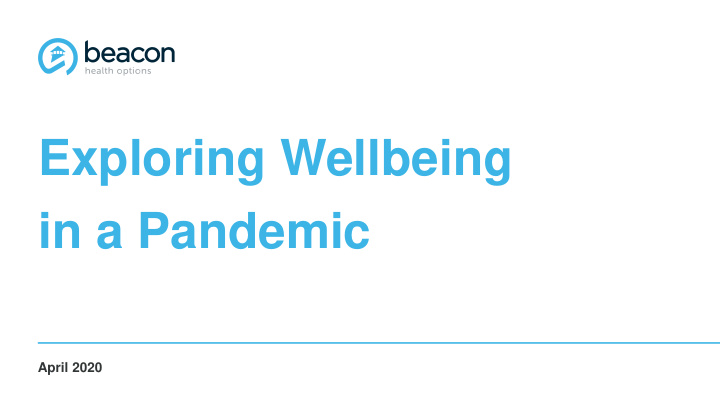



Exploring Wellbeing in a Pandemic April 2020 1
Goals for Today • Explore the various aspects of wellbeing • Understand COVID- 19’s impact on wellbeing • Learning to cope with COVID-19 2
Mindfulness Exercise 30 second mindfulness exercise to help you relax. Just follow along 3
What is Wellbeing? A sense of mental and physical wellness achieved through a balance of 5 key elements Physical Emotional Community Financial Resilience 4
COVID-19 is impacting us in many different ways: Fear, anger, anxiety, sadness, and depression Impacted families Death of loved ones Loss of jobs Loss of usual interactions Loss of routines and rituals 5
The emotional toll of COVID-19 45% 41% say their emotional well- Are feeling more being has worsened stressed 34% 55% Increase in antianxiety Are feeling medication prescriptions more lonely 6
The physical toll of COVID-19 53% 90% know what to do if they feel of Americans have sick or suspect they have the self-quarantined for virus 14 days 14% 31% report the ability to access care say their physical health has gotten worse has worsened of individuals have 3/4 24% say their ability to protect the canceled or skipped large health of their household has gatherings gotten worse 7 https://keyt.com/news/politics/2020/04/01/poll-the-publics-habits-and-coronavirus-expectations-have-changed-significantly-in-the-last-few-weeks/
The financial toll of COVID-19 of Americans say 79% 40% Worry the pandemic they’ve lost a job or will trigger a income due to recession COVID-19 25% 41% of Americans have been Feel the economy will furloughed, laid off or had be weakened for a their employers close few years 8 KFF.org – Coronavirus (COVID-19) Ipsos.com – Axios/Ipsos coronavirus survey
Wellness is not the absence of illness. One can strive for wellness even if one’s experiences challenge one’s life. 9
The impact is not static A lot of research has looked at what occurs to Typical emotional response during the the individuals and community after a phases of a disaster disaster occurs The impacts of a disaster can mirror some of the impacts of the pandemic With the pandemic the time line may not be as clear as with a specific event (such as a tornado or flood) The process can be different for different people dependent on life circumstances Throughout this process, there is a process of grieving. 10 10 10 10
Ways to Cope Take a Break Distract yourself Gain Control in Small Steps Vary your routine 11 11 11 11
Ways to Cope Find ways to celebrate Practice gratitude Maintain healthy habits Practice Mindfulness 12 12 12 12
Ways to Cope Develop a community of support Foster optimism Develop and nurture a sense of humor Practice Self-Compassion Develop a schedule 13 13 13 13
Help is available If you continue to experience ongoing difficulties this is also very common after a disaster Some common symptoms can include: Sleep disturbance Anxiety Depression Increased irritability Help is out there, please call the number on the back of your insurance card. 14 14 14 14
After the crisis is over… For many people surviving a disaster they discover things about themselves. Achieve heightened sense community Deeper recognition of meaning and purpose Better able to cope with future life stressors 15 15 15 15
Mindfulness Exercise Guided Imagery Mindfulness Technique Just follow along 16 16 16 16
References/ Suggested Readings www.beaconhealthoptions.com/coronavirus 17 17 17 17
Appendix- Mindfulness Exercise First, sit up, put your feet on the floor and rest your hands in your lap. Inhale slowly. One…two…three…four. Hold that breath a few seconds and mentally say the word, ‘relax’. Exhale slowly. One…two…three…four…five. Inhale again slowly. One…two…three…four. Hold that breath and mentally say the word, ‘calm’. Exhale slowly. One…two…three…four…five. Inhale slowly. One…two…three…four. Hold that breath and mentally say the word, ‘peaceful’. Exhale slowly. One…two…three…four…five. Notice that you feel more relaxed than you did just a minute ago. 18 18 18 18
Appendix Mindfulness Exercise I want you to try another very brief mindfulness exercise. This one uses a technique called guided imagery. Make sure you’re sitting comfortably. Leave your arms and legs uncrossed, feet on the floor, hands in your lap. Close your eyes. Think of a place that’s safe and calm. It could be a real place you’ve been to or an imaginary one. It could be a place that bring s back fond memories. Preferably , it’s somewhere outdoors and a natural setting. A beach, a park, a forest, a desert or a mountain… sitting around a campfir e, watching the waves roll in, having a picnic or seeing a stream fall over some rocks. Ideally , you’re alone or with a just few loved ones. Crowds can be fun but they’re still stressful . Have you got your calm place? Now, pay attention to what your senses are telling you about that place. What do you see in your mind? Water? Birds? Trees? Animals? What do you hear? Surf? Leaves rustling? Firewood popping and cracking? What do you feel? The wind blowing across your face? Your body against the sand? What do you smell? Flowers? Food cooking somewhere? Wood smoke? The forest floor? Take a moment in that calm place to soak in all these sensations at the same time. Take a few slow breaths and, when you’re ready, open your eyes. 19 19 19 19
Thank you Contact Us Lisa Kugler, Psy.D. Mahmood (Mike) Usman, MD, MMM Lisa.Kugler@beaconhealthoptions.com Mahmood.Usman@beaconhealthoptions.com 20 20 20 20
Recommend
More recommend